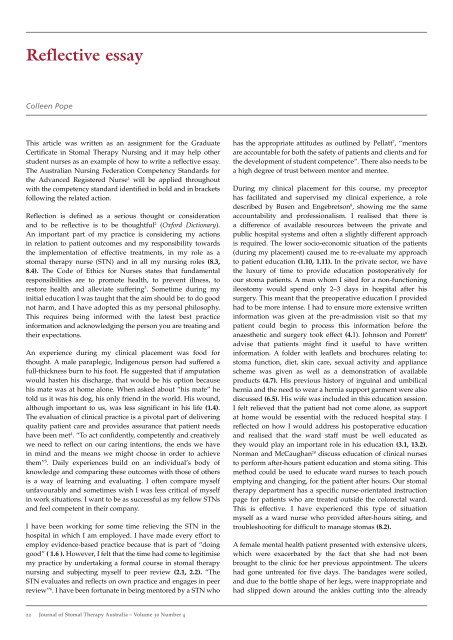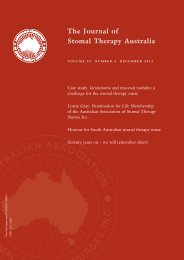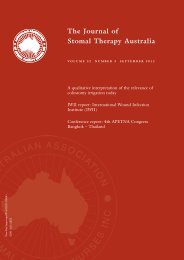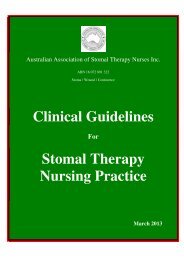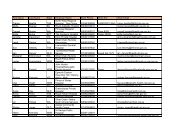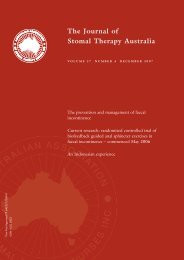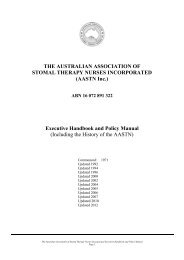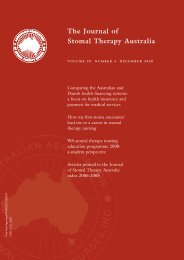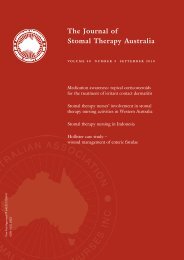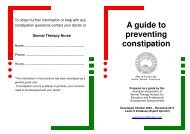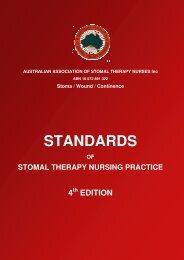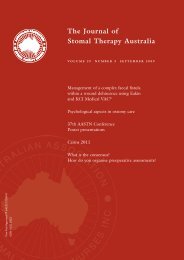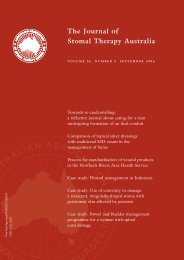JSTA December 2010 - Australian Association of Stomal Therapy ...
JSTA December 2010 - Australian Association of Stomal Therapy ...
JSTA December 2010 - Australian Association of Stomal Therapy ...
Create successful ePaper yourself
Turn your PDF publications into a flip-book with our unique Google optimized e-Paper software.
Reflective essay<br />
Colleen Pope<br />
This article was written as an assignment for the Graduate<br />
Certificate in <strong>Stomal</strong> <strong>Therapy</strong> Nursing and it may help other<br />
student nurses as an example <strong>of</strong> how to write a reflective essay.<br />
The <strong>Australian</strong> Nursing Federation Competency Standards for<br />
the Advanced Registered Nurse 1 will be applied throughout<br />
with the competency standard identified in bold and in brackets<br />
following the related action.<br />
Reflection is defined as a serious thought or consideration<br />
and to be reflective is to be thoughtful 2 (Oxford Dictionary).<br />
An important part <strong>of</strong> my practice is considering my actions<br />
in relation to patient outcomes and my responsibility towards<br />
the implementation <strong>of</strong> effective treatments, in my role as a<br />
stomal therapy nurse (STN) and in all my nursing roles (8.3,<br />
8.4). The Code <strong>of</strong> Ethics for Nurses states that fundamental<br />
responsibilities are to promote health, to prevent illness, to<br />
restore health and alleviate suffering 3 . Sometime during my<br />
initial education I was taught that the aim should be: to do good<br />
not harm, and I have adopted this as my personal philosophy.<br />
This requires being informed with the latest best practice<br />
information and acknowledging the person you are treating and<br />
their expectations.<br />
An experience during my clinical placement was food for<br />
thought. A male paraplegic, Indigenous person had suffered a<br />
full-thickness burn to his foot. He suggested that if amputation<br />
would hasten his discharge, that would be his option because<br />
his mate was at home alone. When asked about “his mate” he<br />
told us it was his dog, his only friend in the world. His wound,<br />
although important to us, was less significant in his life (1.4).<br />
The evaluation <strong>of</strong> clinical practice is a pivotal part <strong>of</strong> delivering<br />
quality patient care and provides assurance that patient needs<br />
have been met 4 . “To act confidently, competently and creatively<br />
we need to reflect on our caring intentions, the ends we have<br />
in mind and the means we might choose in order to achieve<br />
them” 5 . Daily experiences build on an individual’s body <strong>of</strong><br />
knowledge and comparing these outcomes with those <strong>of</strong> others<br />
is a way <strong>of</strong> learning and evaluating. I <strong>of</strong>ten compare myself<br />
unfavourably and sometimes wish I was less critical <strong>of</strong> myself<br />
in work situations. I want to be as successful as my fellow STNs<br />
and feel competent in their company.<br />
I have been working for some time relieving the STN in the<br />
hospital in which I am employed. I have made every effort to<br />
employ evidence-based practice because that is part <strong>of</strong> “doing<br />
good” ( 1.6 ). However, I felt that the time had come to legitimise<br />
my practice by undertaking a formal course in stomal therapy<br />
nursing and subjecting myself to peer review (2.1, 2.2). “The<br />
STN evaluates and reflects on own practice and engages in peer<br />
review” 6 . I have been fortunate in being mentored by a STN who<br />
22 Journal <strong>of</strong> <strong>Stomal</strong> therapy australia – Volume 30 Number 4<br />
has the appropriate attitudes as outlined by Pellatt 7 , “mentors<br />
are accountable for both the safety <strong>of</strong> patients and clients and for<br />
the development <strong>of</strong> student competence”. There also needs to be<br />
a high degree <strong>of</strong> trust between mentor and mentee.<br />
During my clinical placement for this course, my preceptor<br />
has facilitated and supervised my clinical experience, a role<br />
described by Busen and Engebretson 8 , showing me the same<br />
accountability and pr<strong>of</strong>essionalism. I realised that there is<br />
a difference <strong>of</strong> available resources between the private and<br />
public hospital systems and <strong>of</strong>ten a slightly different approach<br />
is required. The lower socio-economic situation <strong>of</strong> the patients<br />
(during my placement) caused me to re-evaluate my approach<br />
to patient education (1.10, 1.11). In the private sector, we have<br />
the luxury <strong>of</strong> time to provide education postoperatively for<br />
our stoma patients. A man whom I sited for a non-functioning<br />
ileostomy would spend only 2–3 days in hospital after his<br />
surgery. This meant that the preoperative education I provided<br />
had to be more intense. I had to ensure more extensive written<br />
information was given at the pre-admission visit so that my<br />
patient could begin to process this information before the<br />
anaesthetic and surgery took effect (4.1). Johnson and Porrett 9<br />
advise that patients might find it useful to have written<br />
information. A folder with leaflets and brochures relating to:<br />
stoma function, diet, skin care, sexual activity and appliance<br />
scheme was given as well as a demonstration <strong>of</strong> available<br />
products (4.7). His previous history <strong>of</strong> inguinal and umbilical<br />
hernia and the need to wear a hernia support garment were also<br />
discussed (6.5). His wife was included in this education session.<br />
I felt relieved that the patient had not come alone, as support<br />
at home would be essential with the reduced hospital stay. I<br />
reflected on how I would address his postoperative education<br />
and realised that the ward staff must be well educated as<br />
they would play an important role in his education (3.1, 13.2).<br />
Norman and McCaughan 10 discuss education <strong>of</strong> clinical nurses<br />
to perform after-hours patient education and stoma siting. This<br />
method could be used to educate ward nurses to teach pouch<br />
emptying and changing, for the patient after hours. Our stomal<br />
therapy department has a specific nurse-orientated instruction<br />
page for patients who are treated outside the colorectal ward.<br />
This is effective. I have experienced this type <strong>of</strong> situation<br />
myself as a ward nurse who provided after-hours siting, and<br />
troubleshooting for difficult to manage stomas (8.2).<br />
A female mental health patient presented with extensive ulcers,<br />
which were exacerbated by the fact that she had not been<br />
brought to the clinic for her previous appointment. The ulcers<br />
had gone untreated for five days. The bandages were soiled,<br />
and due to the bottle shape <strong>of</strong> her legs, were inappropriate and<br />
had slipped down around the ankles cutting into the already


